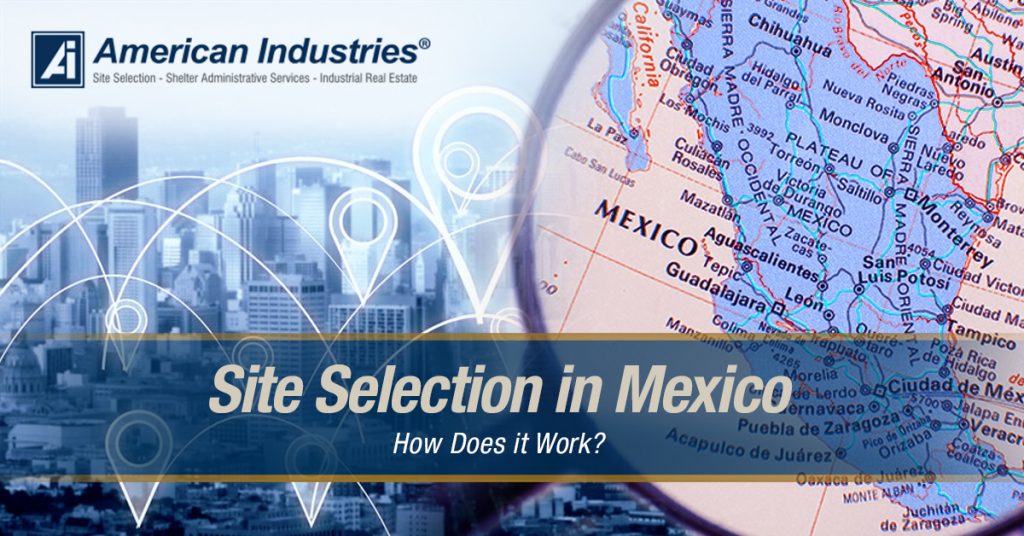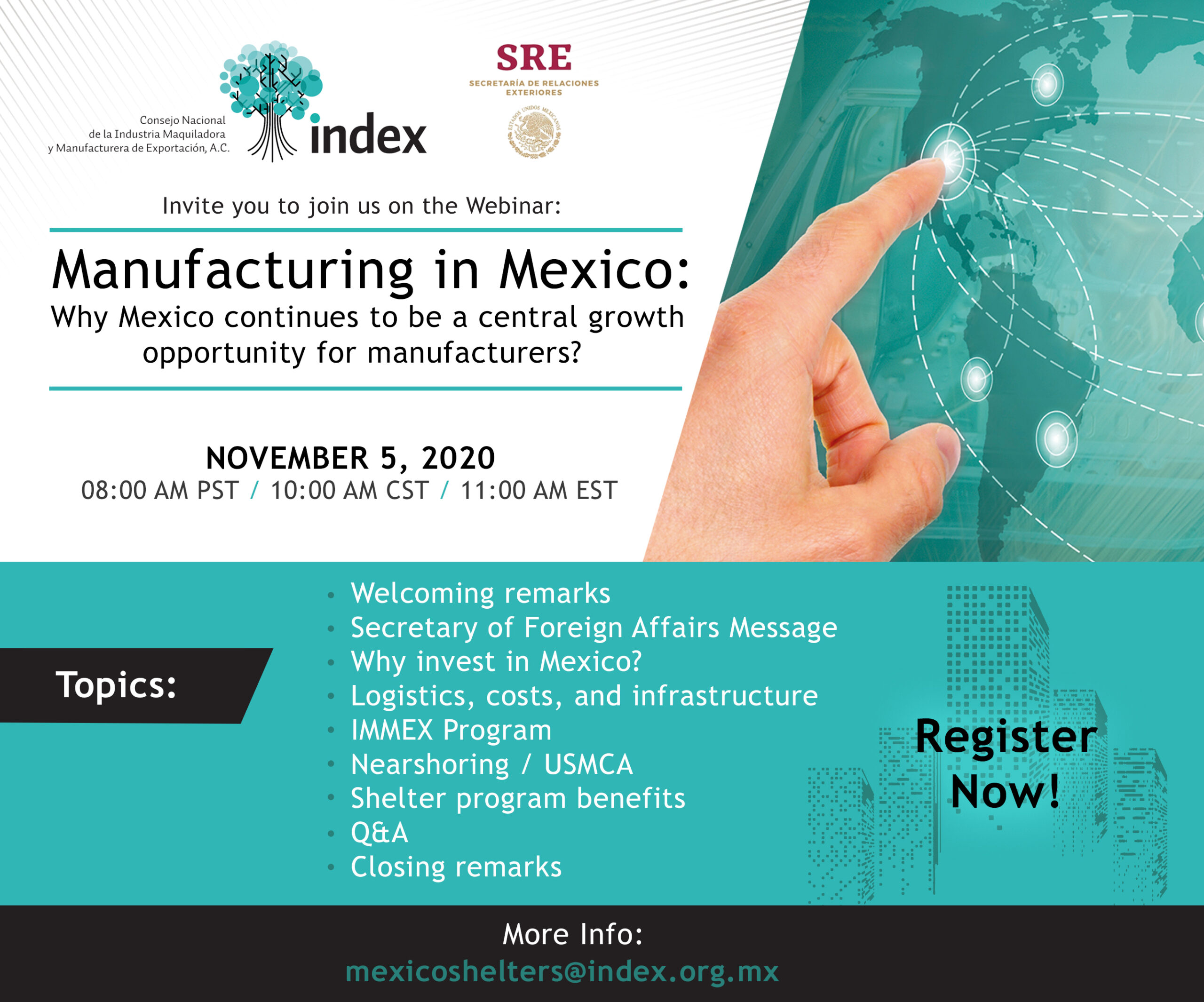Manufacturing in Mexico: Shelter Operations
November 04, 2020

With the rising global trend of re-shoring operations to create more resilient supply chains across a variety of industries—and Mexico being one of the most logical choices to invest—many corporations wonder if setting up their manufacturing in Mexico is the right move for their company. When considering relocating an operation, one of the most important elements in success is choosing the ideal site to meet each company’s specific needs. For this, it is a good idea to work with a partner with proven experience in operating in different locations within the country, such as a company providing shelter services in Mexico. Read below to find out more about how companies can take advantage of their expertise and the detailed process of site selection Mexico.
The site selection process has evolved dramatically over the last 20 years for a variety of reasons. Some of these factors include the availability of massive amounts of new site selection data, the development of advanced applications and tools to analyze site selection data, sheer economic growth and corporate expansion during this period, and the overall globalization of corporations.
Due to the increased complexity of the site selection process, it has become more challenging for companies to carry out this process themselves. If companies want to minimize the risk of making the wrong location decision, then it is important to rely on experts who proactively maintain global location intelligence data, possess the tools to evaluate locations, and have first-hand experience in the various areas of a country.
To help companies understand the key steps of the modern-day site selection process, the following process provides a great roadmap for companies trying to find the best onshore, nearshore and offshore locations to expand.
The first step is to establish a project team. The team will typically include representatives from the executive team, business unit, real estate department, logistics department, tax department, human resources, and outside site selection consultants.
The next step is to define the project requirements, which will vary significantly based on the type of project. The requirements for a logistics operation will be dramatically different from those of a manufacturing plant. The project team will need to work together to identify key dates, employee skill requirements, projected headcount, desired labor rates, capital investment, accessibility to customers and suppliers, real estate needs and infrastructure requirements.
After defining the project requirements, bulk data will have to be gathered to create a filtering model with relevant data aligned with your site selection criteria in order to filter locations properly. Typically, companies will use data variables such as population, demographics, unemployment rate, cost of living, utility costs, industry presence, inbound and outbound materials, wage rates, union rates, tax rates, time zone and other variables to create a long list of five to eight locations. Be careful. Many companies often think they can decide from this level of data, which is typically a major mistake.
This will allow you to then identify the finalist locations. The site selection team will need to perform a thorough workforce, infrastructure, logistics, business climate, economic incentive, and real estate market analysis of the five to eight candidate locations. This research will include gathering detailed demographic data and primary research that will be analyzed in various site selection models. The following provides a sample of the information that needs to be uncovered and compared utilizing a matrix-type approach:
- Demographics
- Educational attainment of the population and college and universities in the area
- Historic unemployment rates
- Location, size, and wages of competitors
- Local employment drivers
- Economic dynamics of the location: new projects developed, expansions, closures
- Wage rates
- Infrastructure (roads, utilities, fiber, etc.)
- Utility costs (electric, water, gas)
- Logistics and transportation costs
- Proximity to customers and suppliers
- Applicable federal, state and city tax rates, as well as other permits and licenses
- Real estate availability
- Government incentives and support programs
- Best framework for operating in Mexico
Using this data, the project team will identify a shortlist of locations using a weighted model that scores each location based on quantitative and qualitative factors, such as labor market scalability, employee demographics, labor quality, competition, supplemental labor sources, cost of living and wages, business environment, accessibility, logistics, operating costs, real estate availability and the economic incentive environment. This model will then allow them to choose two to three finalist locations.
Once the shortlisted sites have been agreed upon, the project team will conduct on-site community due diligence to gain a thorough understanding of what a particular area has to offer. The tours will typically take one to two days per community in international locations. During the tours, the project team will meet with community leaders, regional economic development officials, workforce training representatives, staffing agencies, local employers, utility providers and real estate brokers. The anecdotal evidence uncovered during the tours will be crucial to the site selection process’s success and enable the team to fully understand the qualitative differences of each shortlist location.
Concurrently to the site visits, the project team will initiate the negotiation of economic incentives and real estate terms. It is critical to carefully control the negotiation process to have maximum leverage and make sure commitments for real estate don’t conflict with a company’s ability to secure economic incentives.
Economic incentives negotiations will typically be managed by someone from the site selection consultant team, who will initiate formal discussions with local and state leaders to confirm the availability of economic incentives such as tax credits, tax abatements, cash grants, training subsidies, utility rebates and other related incentives.
Real estate terms will be negotiated at the same time as economic incentives by the real estate director or site selection consultant. If a local commercial real estate broker is hired, it is critical to enlist a firm that only represents tenants, not owners, to ensure there are no conflicts of interest. Negotiations will revolve around finalizing terms, including the size of the space, rental rate or purchase price, concessions, improvements, renewals, and expansions.
Once the economic incentives and real estate are secured, the next phase is to plan the project construction, which varies greatly in complexity depending on if it is an existing building or a greenfield site. The construction team will develop detailed project budgets and schedules for the project and follow it through to move-in. Selecting the vendors, such as architects, engineers, and general contractors with experience working on similar facilities can prove critical to delivering the project on-time and within budget. A general contractor or developer will help to achieve this.
One of the most frequently neglected steps in the site selection process is economic incentive compliance. You may think that the site selection process is finished upon move-in, when in reality, it never stops. For you to take advantage of the economic incentives that allowed the project proforma to receive final approval from your executive team, you have to stay in compliance. This will require you to submit payroll reports, employee training expenses, capital investment, and real and personal property tax information to multiple economic development and government entities. This data will have to be submitted monthly, quarterly or annually depending on the specific economic incentive requirement stipulated in your agreement. If you fail to stay in compliance, then you will often lose your ability to access those funds. This is why so many companies fail to actually receive the full benefit of the economic incentives they thought they would receive.
Using this process for site selection in Mexico allows companies to compare different sites easily and have the confidence that they are making the most informed decision in line with their priorities. It is carried out without the company ever having to visit Mexico so that when they decide to make the trip, they will know that they have done their due diligence. This not only saves time and money, but most importantly, guarantees that everything is in place to ensure the success of international companies in Mexico.
CONTACT US
Be part of one of our success stories!
Phone:
(55) 22829901
Mail:
mexicoshelters@index.org.mx
Address:
Ejército Nacional 418 Piso 12
Chapultepec Morales, CDMX, CP.11570




